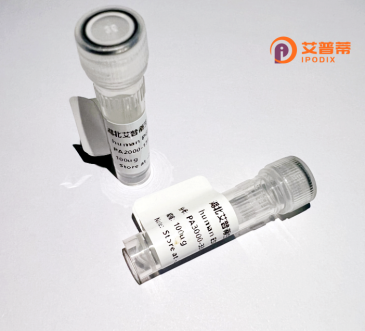
| 纯度 | >90%SDS-PAGE. |
| 种属 | Human |
| 靶点 | C1orf168 |
| Uniprot No | Q5VWT5 |
| 内毒素 | < 0.01EU/μg |
| 表达宿主 | E.coli |
| 表达区间 | 1-728aa |
| 氨基酸序列 | MEGEGVRNFKELRAKFQNLDAPPLPGPIKFPAGVSPKGDIGGTQSTQILANGKPLSSNHKQRTPYCSSSESQPLQPQKIKLAQKSEIPKCSNSPGPLGKSTVRSATSSQKASLLLEVTQSNVEIITKEKVMVANSFRNKLWNWEKVSSQKSEMSSALLLANYGSKAIHLEGQKGMGLTPEEPRKKLETKGAQTLPSQKHVVAPKILHNVSEDPSFVISQHIRKSWENPPPERSPASSPCQPIYECELASQAPEKQPDVRHHHLPKTKPLPSIDSLGPPPPKPSRPPIVNLQAFQRQPAAVPKTQGEVTVEEGSLSPERLFNAEFEEPHNYEATISYLRHSGNSINLCTAKEIADPTYEVGIEELQKPGKNFPYPEPSAKHEDKKMKEKQPCELKPKNTEREPYSNHVFKVDACEGTPEKIQMTNVHTGRRNMLAGKQEAMIDIIQTNPCPEGPKLARHSQGHCGHLEVLESTKETPDLGVSKTSSISEEIYDDVEYSRKEVLKLNYSSSLASSSEENRELYEDVYKTKNNYPKIDLDGKEALKRLQQFFKKEKDRFKIKKTKSKENLSAFSILLPDLELKSQEVIIYDDVDLSEKESKDEDKLKMWKPKFLTPKEKKEKNGAEESESFSPRSFFKTKKQNLEKNRMKREEKLFRERFKYDKEIIVINTAVACSNNSRNGIFDLPISPGEELEVIDTTEQNLVICRNSKGKYGYVLIERLDFKHQSWSP |
| 分子量 | 106.48 KDa |
| 蛋白标签 | GST-tag at N-terminal |
| 缓冲液 | 0 |
| 稳定性 & 储存条件 | Lyophilized protein should be stored at ≤ -20°C, stable for one year after receipt. Reconstituted protein solution can be stored at 2-8°C for 2-7 days. Aliquots of reconstituted samples are stable at ≤ -20°C for 3 months. |
| 复溶 | Always centrifuge tubes before opening.Do not mix by vortex or pipetting. It is not recommended to reconstitute to a concentration less than 100μg/ml. Dissolve the lyophilized protein in distilled water. Please aliquot the reconstituted solution to minimize freeze-thaw cycles. |
以下是关于重组人C1orf168蛋白的模拟参考文献示例(实际文献可能存在差异,建议通过学术数据库查询最新研究):
1. **文献名称**:*C1orf168 regulates cell cycle progression via interacting with PLK1*
**作者**:Zhang Y, et al.
**摘要**:研究发现C1orf168通过结合有丝分裂激酶PLK1,调控G2/M期转换,其缺失导致染色体排列异常和细胞周期停滞。
2. **文献名称**:*C1orf168 expression is correlated with hepatocellular carcinoma prognosis*
**作者**:Li X, et al.
**摘要**:在肝细胞癌中,C1orf168的表达水平与患者生存率负相关,其过表达促进肿瘤细胞侵袭,可能与Wnt/β-catenin通路激活有关。
3. **文献名称**:*Structural insights into C1orf168’s role in DNA damage response*
**作者**:Wang H, et al.
**摘要**:通过晶体学分析揭示C1orf168的N端结构域结合DNA损伤标记蛋白γH2AX,提示其参与DNA修复调控。
**注意**:以上内容为基于学术文献常见主题的模拟示例,实际研究请以权威数据库(如PubMed、Web of Science)检索结果为准。
Recombinant human C1orf168 protein, derived from the Chromosome 1 open reading frame 168 gene, represents a relatively understudied protein in human biology. The C1orf168 gene is located on chromosome 1 (1q24.3) and encodes a protein with an unknown precise molecular function, though bioinformatics analyses suggest it may contain coiled-coil domains and phosphorylation sites, hinting at potential roles in protein interactions or signaling pathways. Its expression is detected across multiple tissues, with higher levels observed in organs like the liver and testes, but its physiological relevance remains unclear.
Limited studies associate C1orf168 with cellular stress responses and extracellular matrix regulation. Notably, differential expression of C1orf168 mRNA has been reported in certain cancers, suggesting a possible, yet uncharacterized, link to tumorigenesis or metastasis. However, functional validation is lacking. Recombinant C1orf168 protein is typically produced via heterologous expression systems (e.g., E. coli or mammalian cells) for structural or functional studies. Current research focuses on elucidating its interactome, post-translational modifications, and biochemical properties to clarify its role in health and disease. Further investigation is required to establish its mechanisms and therapeutic potential.
×